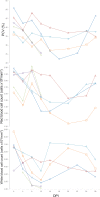Clinical and serological evaluation of capybaras (Hydrochoerus hydrochaeris) successively exposed to an Amblyomma sculptum-derived strain of Rickettsia rickettsii
- PMID: 31969607
- PMCID: PMC6976648
- DOI: 10.1038/s41598-020-57607-5
Clinical and serological evaluation of capybaras (Hydrochoerus hydrochaeris) successively exposed to an Amblyomma sculptum-derived strain of Rickettsia rickettsii
Erratum in
-
Author Correction: Clinical and serological evaluation of capybaras (Hydrochoerus hydrochaeris) successively exposed to an Amblyomma sculptum-derived strain of Rickettsia rickettsii.Sci Rep. 2020 Mar 11;10(1):4848. doi: 10.1038/s41598-020-61342-2. Sci Rep. 2020. PMID: 32157188 Free PMC article.
Abstract
Brazilian spotted fever (BSF), caused by Rickettsia rickettsii, is the most lethal tick-borne disease in the western hemisphere. In Brazil, Amblyomma sculptum ticks are the main vector. Capybaras (Hydrochoerus hydrochaeris), the largest living rodents of the world (adults weighing up to 100 Kg), have been recognized as amplifying hosts of R. rickettsii for A. sculptum in BSF-endemic areas; i.e., once primarily infected, capybaras develop bacteremia for a few days, when feeding ticks acquire rickettsial infection. We conducted experimental infections of five capybaras with an A. sculptum-derived strain of R. rickettsii and performed clinical and bacteremia evaluation during primary and subsequent infections. Bacteremia was detected in all capybaras during primary infection, but not in subsequent infections. All animals seroconverted to R. rickettsii (titres range: 64-32,768), and remained seropositive throughout the study. Primary infection resulted in clinical spotted fever illness in four capybaras, of which two had a fatal outcome. Subsequent infections in seropositive capybaras resulted in no clinical signs. Capybaras developed a sustained immune response that prevented a second bacteremia. This condition may imply a high reproduction rate of capybaras in BSF-endemic areas, in order to continuously generate capybaras susceptible to bacteremia during primary infection.
Conflict of interest statement
The authors declare no competing interests.
Figures








References
Publication types
MeSH terms
LinkOut - more resources
Full Text Sources

